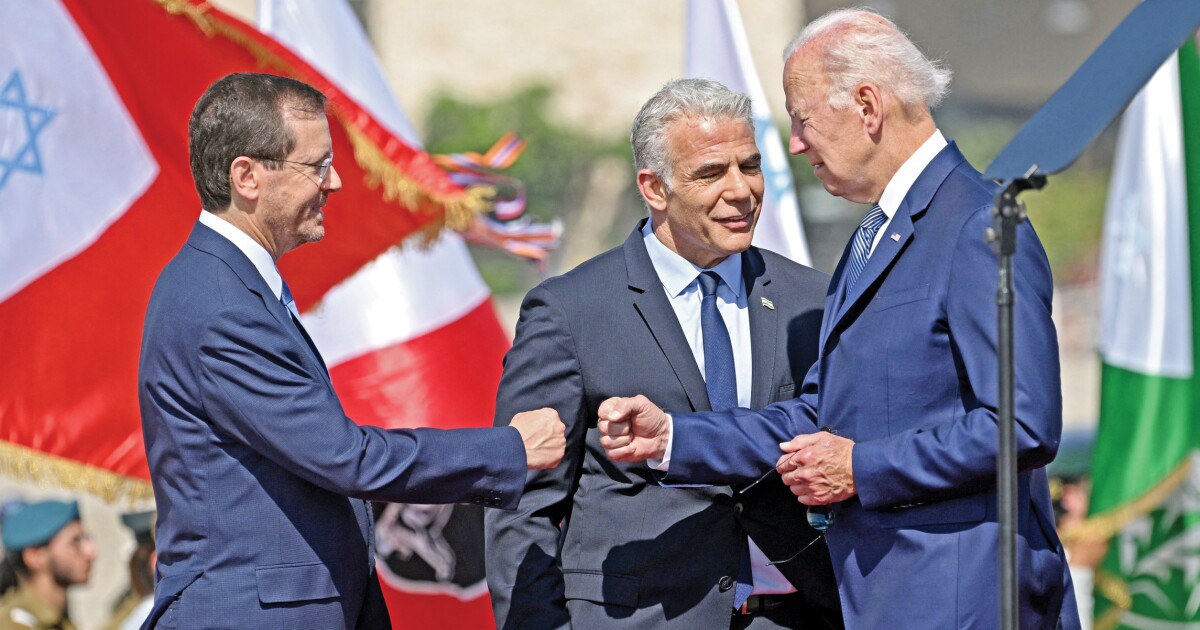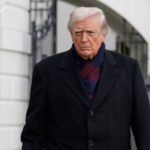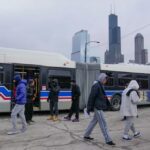

Behind the scenes, President Joe Biden’s first visit to the Middle East was a study in contrasts. In Israel, Biden’s decadeslong familiarity with the country and its people was put on display. That gave way to caution and stage management on the other end of the historic flight from Tel Aviv to Jeddah, where the president would meet with Crown Prince Mohammed bin Salman, who U.S. intelligence says was complicit in the grisly assassination of a Saudi journalist living in America.
At stake was the potential for Saudi Arabia to boost its oil output and ease political pressure on Biden and the Democrats heading into the midterm elections amid unease over gas prices and inflation.
Tuesday, July 12
7:46 p.m.
Ahead of Biden’s arrival, White House reporters gathered for a balmy outdoor dinner hosted by the mayor of Jerusalem and U.S. Ambassador to Israel Thomas Nides. The visit, Nides insisted at the cobbled restaurant overlooking Jerusalem’s Old City, was not Biden’s “first trip of the rodeo.”
The ambassador posed for at least a dozen selfies with guests, gamely grinning and gripping until the Washington Examiner asked whether he always garnered such a rapturous crowd. “It’s fine, who cares?” Nides retorted, waving away the attention.
Wednesday, July 13
9:56 a.m.
After the customary swirl of a daily coronavirus test, this reporter ventured into the city before Biden’s arrival, which inflicted the usual road closures and delays, to draw reactions from Jerusalem locals. “Trump was better for Israel,” one 26-year-old local told the Washington Examiner, “but Biden is my problem now.”
3:09 p.m.
Biden greets Prime Minister Yair Lapid and President Isaac Herzog with fist bumps, as doctor’s orders were to avoid handshakes, according to the White House. The tension between official guidance and reality continued unabated. “You know I love you,” Biden told Benjamin Netanyahu, the longtime premier and current opposition leader, when the two reunited with a clasp of their hands.
More handshakes ensued, including with Israeli Defense Minister Benny Gantz. Later, photographs showed the president dropping to one knee to speak with two American Holocaust survivors before embracing them.
7:21 p.m.
After calling a “lid” on the president’s day, the White House tells reporters that Biden has pretaped an interview with Israel’s Channel 12 set to air in 40 minutes. Journalists scramble into position, abandoning dinner plans for their laptops.
Thursday, July 14
9:30 a.m.
Over shakshuka and coffee, hotel guests sidle up to CNN anchor Wolf Blitzer for selfies. (Blitzer is a familiar famous face to the Israelis, having begun covering the country in the 1970s as a local correspondent.)
11 a.m.
Journalists credentialed for Biden’s press conference streamed into the lobby of Jerusalem’s Waldorf Astoria hotel. Guests beneath the glass-ceilinged atrium appeared unfazed by possibly hundreds of Secret Service agents and U.S. and Israeli officials milling about.
2:34 p.m.
Biden takes questions from just two American reporters.
Friday, July 15
6:30 a.m.
The day began in Jerusalem and ended in Jeddah.
As dawn broke over Ben Gurion Airport in Tel Aviv, White House reporters boarded the first commercial flight to Saudi Arabia, hours after the kingdom began permitting such flights.
Biden would make the same journey to Jeddah, becoming the first American president to fly directly to the coastal city from Israel, a feat White House officials reminded reporters of near daily.
Jeddah, 5:53 p.m.
All eyes were on Biden for his 23-hour stop in Saudi Arabia. But the eyes would have to watch from a distance.
When Biden arrived at the Al Salam Royal Palace, only Saudi media were in position to capture the inaugural fist bump between the American president and the crown prince. State media pushed it out immediately, blanketing social media.
The White House, which controls U.S. reporters’ movements, provided no such opportunity. A note previewing the president’s arrival said simply that Biden would be “greeted by the Royal Family.”
7:34 p.m.
In a sweeping gilded room, a small pool of reporters awaited Biden and Mohammed bin Salman, Saudi Arabia’s de facto leader, culminating months of speculation over the president’s plan to handle a relationship that he has been reluctant to acknowledge.
When an American journalist asked if the crown prince would apologize to Jamal Khashoggi’s family, MBS smirked. Biden ignored a question about whether he still considered Saudi Arabia a “pariah.” The state-owned Al Arabiya cutits broadcast as reporters began asking questions.
10 p.m.
Biden did not have public remarks on his schedule arriving in Saudi Arabia. That changed with a late addition to his schedule. He would deliver remarks in 30 minutes, the White House said.
Nearby, a handful of print reporters were preparing to sit down with two Saudi officials who attended Biden’s meetings with MBS.
10:39 p.m.
The timing of the two events coincided almost exactly.
A coordinator for the Saudi officials had twice pushed back the sit-down and now began ushering into the room reporters from the Wall Street Journal, Washington Post, and Washington Examiner to begin an interview in which they contested Biden’s claim to have confronted MBS over Khashoggi’s murder.
Six minutes in, Biden began speaking in a virtual split screen of the scene a few miles away.
Saturday, July 16
8:14 a.m.
Already, a hot, wet fog had settled over Jeddah, the kingdom’s second city and once its economic capital on the Red Sea, as senior administration officials briefed reporters on “the Biden doctrine” that the president would lay out during a summit with Gulf leaders.
11:24 a.m.
Biden had teased an increase in oil production from Saudi Arabia. But the president appeared to meet public resistance when the crown prince said the kingdom could extend its oil production by a million barrels but no more, indicating that to do so would risk inflation.
In the lobby of the InterContinental, a fixer for the Saudi minister of state for foreign affairs voiced frustration after a reporter failed to answer his phone after seven tries.
It wasn’t just American journalists facing restrictions. The coordinator said the minister was “trying to get security to release him from the Ritz.”
4:45 p.m.
Reporters watched Saudi officials walk Biden down a lavender carpet to the stairway of Air Force One before the president boarded the plane with a wave.
Sunday, July 17
3:30 a.m.
Journalists begin the coastal drive to King Abdulaziz Airport for their return to Tel Aviv on an Egypt Air flight. Once at Ben Gurion Airport, the pool rejoined the Delta charter plane to Washington.
Katherine Doyle is a White House reporter for the Washington Examiner.





